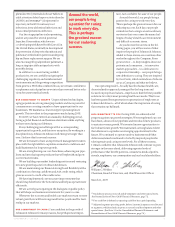Johnson and Johnson 2008 Annual Report Download - page 16
Download and view the complete annual report
Please find page 16 of the 2008 Johnson and Johnson annual report below. You can navigate through the pages in the report by either clicking on the pages listed below, or by using the keyword search tool below to find specific information within the annual report.
JOHNSON & JOHNSON 2008 ANNUAL REPORT
Cork is a very nice town,
friendly people—the only
drawback is the rain,”
says Ibrahim Khadra, Sta
Engineer with Global
Pharmaceutical Supply
Group, LLC, Worldwide Engineering as he
looks back on his recently completed
three-year assignment in Ireland.
“Of course, there’s an advantage to the
rain: It keeps the country green.”
After all, green—green power—is what brought Khadra
to Ireland. He was the project lead responsible for building
a 2.1-megawatt biomass boiler that uses wood chips at
the Centocor Biologics (Ireland) manufacturing facility
(“BioCork”). The boiler replaces half the natural gas used at
the facility and reduces its carbon dioxide (CO2) emissions
by 22 percent. The wood chips that fuel the boiler are the
by-products (such as branches) from logging in sustainable
forests near Cork.
Completed in September 2008,
the biomass boiler is the first project of its kind within
Johnson & Johnson in the biotech sector (a Cilag AG pharmaceu-
tical manufacturing facility in Switzerland also uses a biomass
boiler) and the first such installation for a pharmaceutical company
in Ireland. “It was never a slam dunk,” says Khadra. “Nobody has
done this for a biotech facility, and when you think of biomass, and
you think of burning wood chips, you think of a very dirty operation.”
BioCork manufactures monoclonal antibodies, the basis for
biologic medicines such as ustekinumab (see story on page 12).
Khadra says making the biomass boiler a clean, contained
operation was an intriguing challenge, given the delicate require-
ments for producing monoclonal antibodies.
“We came up with this idea of hook bins, essentially converted
trailers designed with moving oors, which allow us to handle
the wood chips in a very clean, contained way,” says Khadra.
The wood chips are fed by auger into the boiler, where they are
burned to heat water. The resulting steam is used to heat the
facility and run the manufacturing process.
Green Power
As the wood chips burn, carbon dioxide is released into the
atmosphere. Ash produced in the burning process is collected and
used to fertilize new trees, which then absorb CO2, completing a
sustainable, carbon-neutral cycle.
Johnson & Johnson began setting
environmental goals in 1987 and in 1999 established a goal
to reduce CO2 emissions from facilities worldwide by 7 percent
in absolute terms by 2010. By improving energy eciency,
establishing on-site cogeneration and renewable-energy projects,
using green power and purchasing carbon osets, the company is
on target to meet that goal. (See a map of worldwide sustainability
projects on www. jnj.com.)
In 2005, when the BioCork facility was being built, there was
a strong commitment to reduce the new site’s carbon footprint by
approximately 20 percent. “From the initial design, we looked at a
14
























